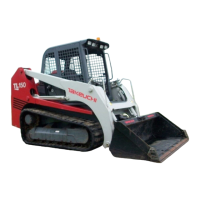III-67
• On a cold day the temperature can drop below zero. The engine may
run cooler so the engine coolant is cooler when it circulates through
the heater. The heat in the cab moves out of the cab faster (remember
heat always moves to a cooler area until both are the same tempera-
ture—nature·s law). To maintain cab comfort you have to increase the
flow of coolant through the heater, increase coolant temperature, and/or
move more air through the heater core.
• On a hot day, an off-road vehicle experiences cooling at a slower rate
than an on-road vehicle. This is a result of high sun-load, large window
area and often less insulation.
It is important for you to keep environmental effects in mind when you are servicing
or diagnosing heater or air conditioner systems. If you work in Denver the altitude will
affect system function and pressure. In Houston the heat and humidity may lower heat
transfer to the air at the condenser and increase system operating pressures.
Chapter Review
• HVAC systems range from simple cab heaters to multi-function com-
bination systems. The multi-function system can heat and cool the cab
and sleeper unit, and have separate auxiliary components and controls
for driver and passenger comfort.
• Both heater (engine) coolant and air conditioner refrigerant circulate
inside sealed, pressurized systems. The normal air conditioner operat-
ing pressure ranges from 150 to 250 pounds per square inch, sometimes
higher with a different refrigerant.
• Air conditioners have a high and a low pressure side within the system.
The compressor is the starting point of the high side. Pressure drops at
the expansion valve opening to the evaporator.
• The basic components of an AC system are the compressorclutch as-
sembly, high pressure lines, condenser, receiver-drier, expansion valve,
evaporator, thermostat, blower assembly, and suction lines. There may
be other controls installed for more complex systems.
• The basic components of a heater system are the inlet and outlet hoses,
a water valve and valve control, heater core and fan or blower assembly.
There may be other controls for more complex systems.
• An air conditioner system uses the “change of state” of refrigerant inside
the system to move heat from the cab air to the outside air. Refrigerant
changes from a gas to a liquid in the condenser, and back to a gas in the
evaporator.
• A heater system uses the heat from the engine, carried to the heater core
by the action of the water pump, to warm the air in the cab. There is no
change of state within the heater system.
• Environmental conditions affect how both heaters and air conditioners
work. Weather, driving conditions, color of the vehicle are factors. All
contribute to heat gain or loss inside a cab and how much heat energy
must be moved to maintain occupant comfort.
System Operation

